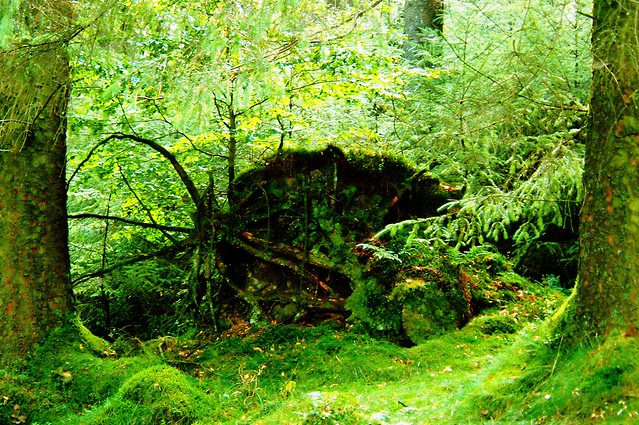One New Year's Day as the Knights of the Round Table are celebrating, a man who is green from head to toe bursts into the hall, mounted on his green horse, and issues a challenge. He will give anyone the chance to strike off his head with his axe, but if they fail, then on the next New Year's Day they must surrender to him the same opportunity. King Arthur accepts but Sir Gawain, his nephew, convinces Arthur to let him be the one to do it, instead. With one blow of the axe he strikes off the Green Knight's head. Much to everyone's astonishment, the Green Knight scoops his head back up, reminds Gawain of the terms of the challenge, and then rides away on his green horse. The rest of the poem is about Gawain's efforts to find the Chapel of the Green Knight and more importantly the temptations he is confronted with prior to the next New Year's Day.
I do have some complaints about the translation. This type of poetry is primarily alliterative.[1] Having looked back at the original text, which is in a difficult-to-read dialect of Middle English (so I'm told—I can't read it at all), there is a lot more alliteration that is lost in this translation. Perhaps to maintain meter (even though meter is less important for alliterative poetry) the translator switches repeatedly between past and present tense. This started to grate on my nerves.
My verdict: Despite my complaints above, overall I enjoyed this book (poem). The language was intriguing and flowed fairly well. I was particularly appreciative of Gawain's plight and the resolution of his temptation (though I feel he started straying too close to the edge of the cliff). And the poet's comparison between hunting and temptation is acute. This is definitely a different type of English poetry than Beowulf (which preceded it) or Shakespeare (who came after). And, of course, it has the allure of being part of the Matter of Britian.[2] I think, though, that I would've enjoyed Tolkien's translation better.
Notes:
[1] It is not completely so, though. After a stanza of variable length which is full of alliterative lines, Sir Gawain and the Green Knight ends with what is called a bob and wheel (see http://en.wikipedia.org/wiki/Bob and wheel), which does utilize rhyme and meter.
[2] i.e. part of the Arthurian romances. See http://en.wikipedia.org/wiki/The Matter of Britain.
Image attributions:
"Green Man" in Bellever Forest is by oddsock (Ian Burt), available at http://www.flickr.com/photos/oddsock/222731724/.
I do have some complaints about the translation. This type of poetry is primarily alliterative.[1] Having looked back at the original text, which is in a difficult-to-read dialect of Middle English (so I'm told—I can't read it at all), there is a lot more alliteration that is lost in this translation. Perhaps to maintain meter (even though meter is less important for alliterative poetry) the translator switches repeatedly between past and present tense. This started to grate on my nerves.
My verdict: Despite my complaints above, overall I enjoyed this book (poem). The language was intriguing and flowed fairly well. I was particularly appreciative of Gawain's plight and the resolution of his temptation (though I feel he started straying too close to the edge of the cliff). And the poet's comparison between hunting and temptation is acute. This is definitely a different type of English poetry than Beowulf (which preceded it) or Shakespeare (who came after). And, of course, it has the allure of being part of the Matter of Britian.[2] I think, though, that I would've enjoyed Tolkien's translation better.
Notes:
[1] It is not completely so, though. After a stanza of variable length which is full of alliterative lines, Sir Gawain and the Green Knight ends with what is called a bob and wheel (see http://en.wikipedia.org/wiki/Bob and wheel), which does utilize rhyme and meter.
[2] i.e. part of the Arthurian romances. See http://en.wikipedia.org/wiki/The Matter of Britain.
Image attributions:
"Green Man" in Bellever Forest is by oddsock (Ian Burt), available at http://www.flickr.com/photos/oddsock/222731724/.

No comments:
Post a Comment